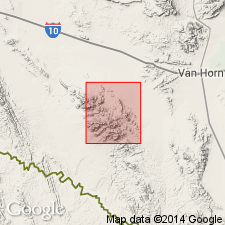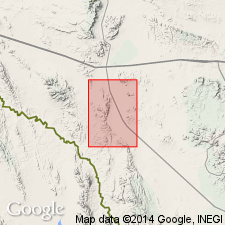
- Usage in publication:
-
- Eagle Mountains sandstone member*
- Modifications:
-
- Original reference
- Dominant lithology:
-
- Sandstone
- Shale
- Siltstone
- Limestone
- AAPG geologic province:
-
- Permian basin
Summary:
Pg. 11 (table 1), 27, 28, 31, pls. 1, 8, 16. Eagle Mountains sandstone member of Grayson formation. Uppermost member of Grayson. About 70 feet of interbedded brown sandstones (some of which are quartzitic), brown shales, siltstones, and sandy limestones; dominantly brown; contrasts strongly with dominant blue-gray of other formations of late Comanche age. Overlies 60-foot middle member informally referred to as reef-limestone. Conformably underlies Buda limestone. Age is Late Cretaceous.
Type locality: Carpenter Canyon at point about 1 mi above Carpenter Wells, Hudspeth Co., southwestern TX. Named from exposures on east side of Eagle Mountains, southwestern TX.
Source: US geologic names lexicon (USGS Bull. 1200, p. 1196-1197).

- Usage in publication:
-
- Eagle Mountains sandstone
- Modifications:
-
- Revised
- AAPG geologic province:
-
- Permian basin
Summary:
Eagle Mountains sandstone. Rank raised to formation. In Van Horn Mountains, overlies Loma Plata limestone, upper member of which is approximately correlative with San Martine member of Boracho limestone (Brand and De Ford, 1958); underlies Buda limestone. Age is Late Cretaceous.
Source: US geologic names lexicon (USGS Bull. 1200, p. 1196-1197).
For more information, please contact Nancy Stamm, Geologic Names Committee Secretary.
Asterisk (*) indicates published by U.S. Geological Survey authors.
"No current usage" (†) implies that a name has been abandoned or has fallen into disuse. Former usage and, if known, replacement name given in parentheses ( ).
Slash (/) indicates name conflicts with nomenclatural guidelines (CSN, 1933; ACSN, 1961, 1970; NACSN, 1983, 2005, 2021). May be explained within brackets ([ ]).

